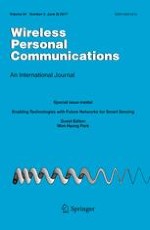24.10.2015
Energy-Efficient Power Control Scheme for Device-to-Device Communications
Erschienen in: Wireless Personal Communications | Ausgabe 3/2017
EinloggenAktivieren Sie unsere intelligente Suche, um passende Fachinhalte oder Patente zu finden.
Wählen Sie Textabschnitte aus um mit Künstlicher Intelligenz passenden Patente zu finden. powered by
Markieren Sie Textabschnitte, um KI-gestützt weitere passende Inhalte zu finden. powered by
